Analysis by Keith Rankin.
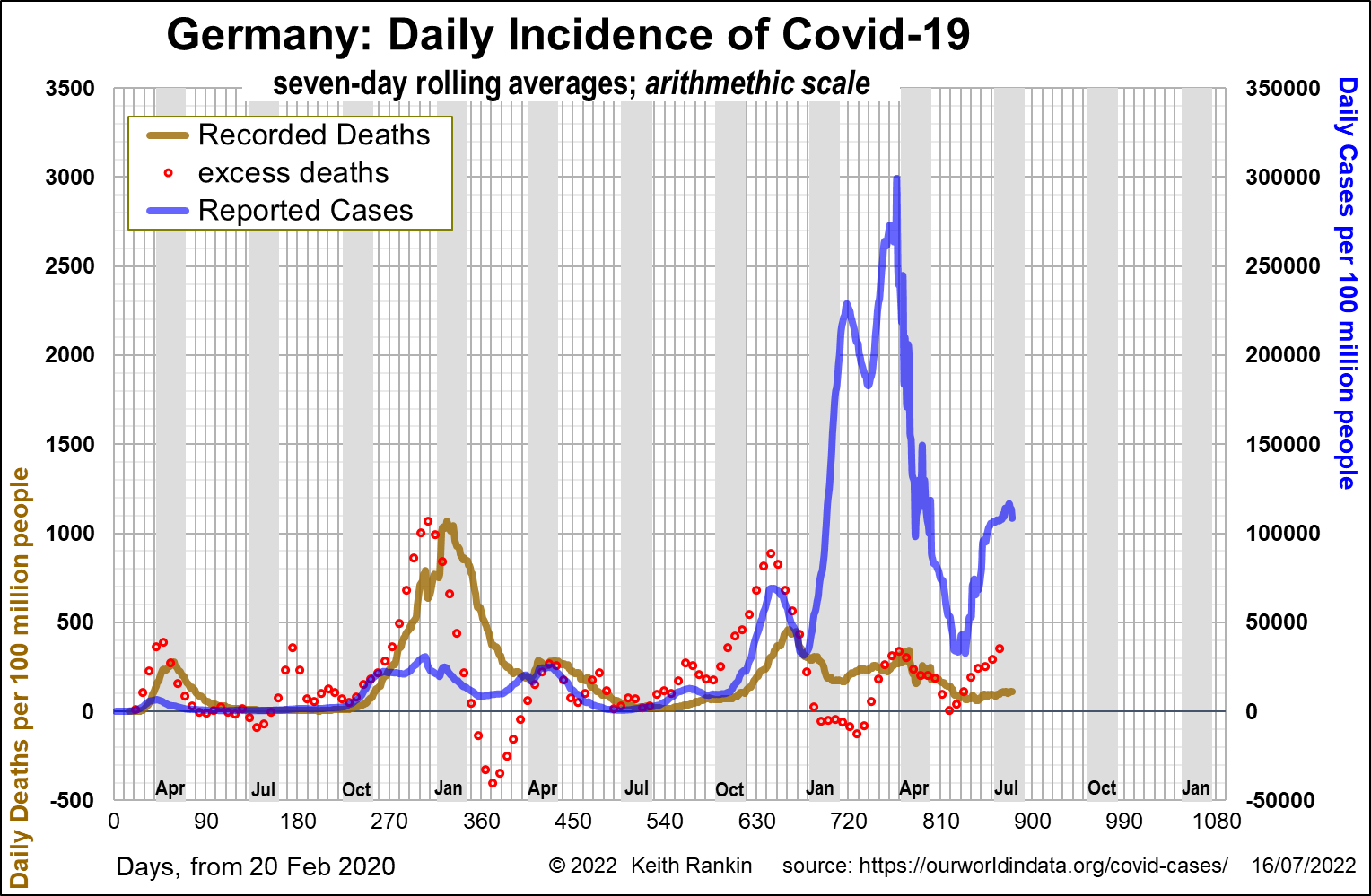

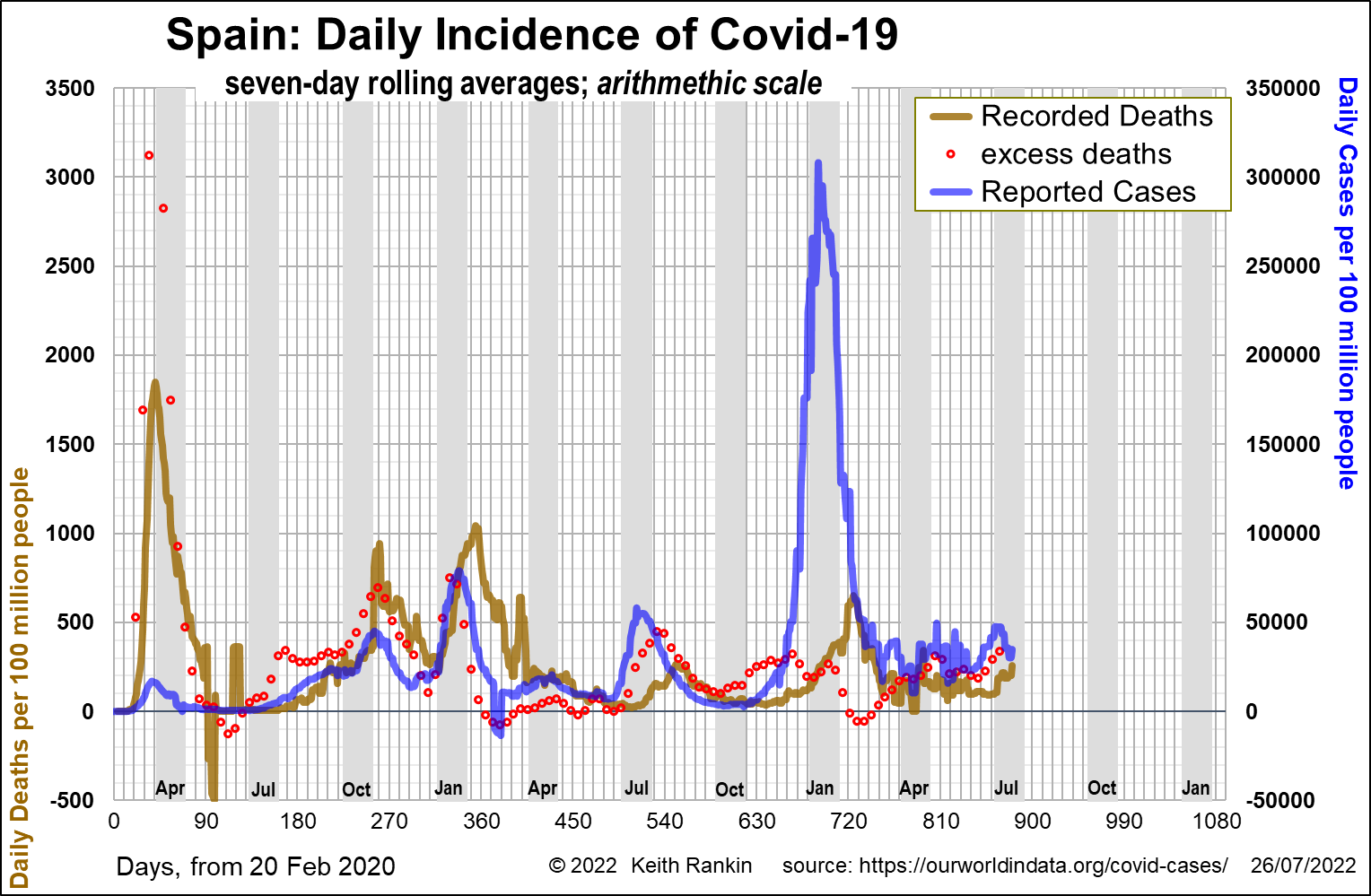
West Europe
The first three charts (above) show three of the larger Western European countries: Germany, France, Spain. (Italy shows a similar picture.)
The most important data item is ‘excess deaths’. (In the case of France and Spain, the last few weeks of this data have been ‘topped up’ using estimates from The Economist, published by Our World in Data. Germany’s data is complete to the end of June, though most countries which release their mortality data promptly do subsequently revise their recent numbers, usually upwards.) For the pandemic as a whole, Germany has ‘lost’ 1530 per million of its population, including 197pm in the first half of this year.
In Germany, we clearly see the ‘Omicron death wave’ in March 2022, a common but by no means universal feature of country charts of this type. Reported covid cases clearly correlate with excess deaths in that month. We are also seeing the same June/July wave in Germany – in its summer – as we are seeing (in winter) in New Zealand. And, there is a clear June/July death wave to match Germany’s ‘case wave’. (Germany’s two worst death waves were in December 2020 [original Wuhan variant] and November 2021 [Delta variant].)
France shows many of the same recent patterns as Germany, though with only about half the severity. Two important differences are that the late 2020 wave came a month earlier in France, indicating that this late 2020 resurgence in Europe was probably driven by tourists from North America; covid levels in the summer of 2020 were much higher in the USA than in Europe.
Overall, France ‘lost’ 1740 per million of its population, including 240pm in the first half of this year. Certainly, France has the look of a more immune population than Germany. And it’s starting to show once again in the French Caribbean; throughout the pandemic, French people – relatively well-adapted to covid – have been conspicuous spreaders of covid through France’s extant empire.
As with Germany, deaths in the present wave do not show up markedly, yet, in the official death statistics; they only show up in excess deaths, meaning many people who have died in this wave have not been acknowledged as covid deaths.
Spain, while much more like France than Germany, still conforms with the general 2022 pattern for Western Europe. While case numbers appear lower in Spain than France, deaths are similar. Overall, Spain ‘lost’ 2570 per million of its population, including 286pm in the first half of this year. Spain looks to be well up the immunity gradient, like France; more so than Germany. This means that I would predict that Germany will have more excess deaths per million in the second half of this year than France and Spain.
We should note the importance of this concept of ‘immunity gradient’. New Zealand (like the much of the Western Pacific region) has a low place on the immunity gradient. This gradient means that countries like France and Spain will be among the most dangerous for New Zealand tourists to visit, at least with respect to catching Covid19. (New Zealand sports teams in Europe this year will be particularly vulnerable to covid, though these younger and fitter sportspeople will generally get through the illness quite quickly. So far, while significant numbers of elite sportspeople from New Zealand have caught covid overseas, almost none seem to have had disabling forms of the illness.)
Thanks to its place on the immunity gradient, in Spain “the pandemic has felt like an afterthought as Spaniards reverted to their usual beach holidays and eagerly welcomed tourists.” Deep in a Covid wave, Europe counts cases and carries on (22 July, NZ Herald courtesy of NY Times).
We should also note that the Scandinavian countries other than Sweden have charts that are similar to the Germany chart; except that their tolls in the first half of the pandemic so far were lower than Germany’s.
East Europe
Here I include charts for Czechia and Hungary, noting that other neighbouring countries – especially Poland and Slovakia – show similar patterns. (The Balkan countries and the former Soviet Union countries are more complex, and will not be further mentioned here.)
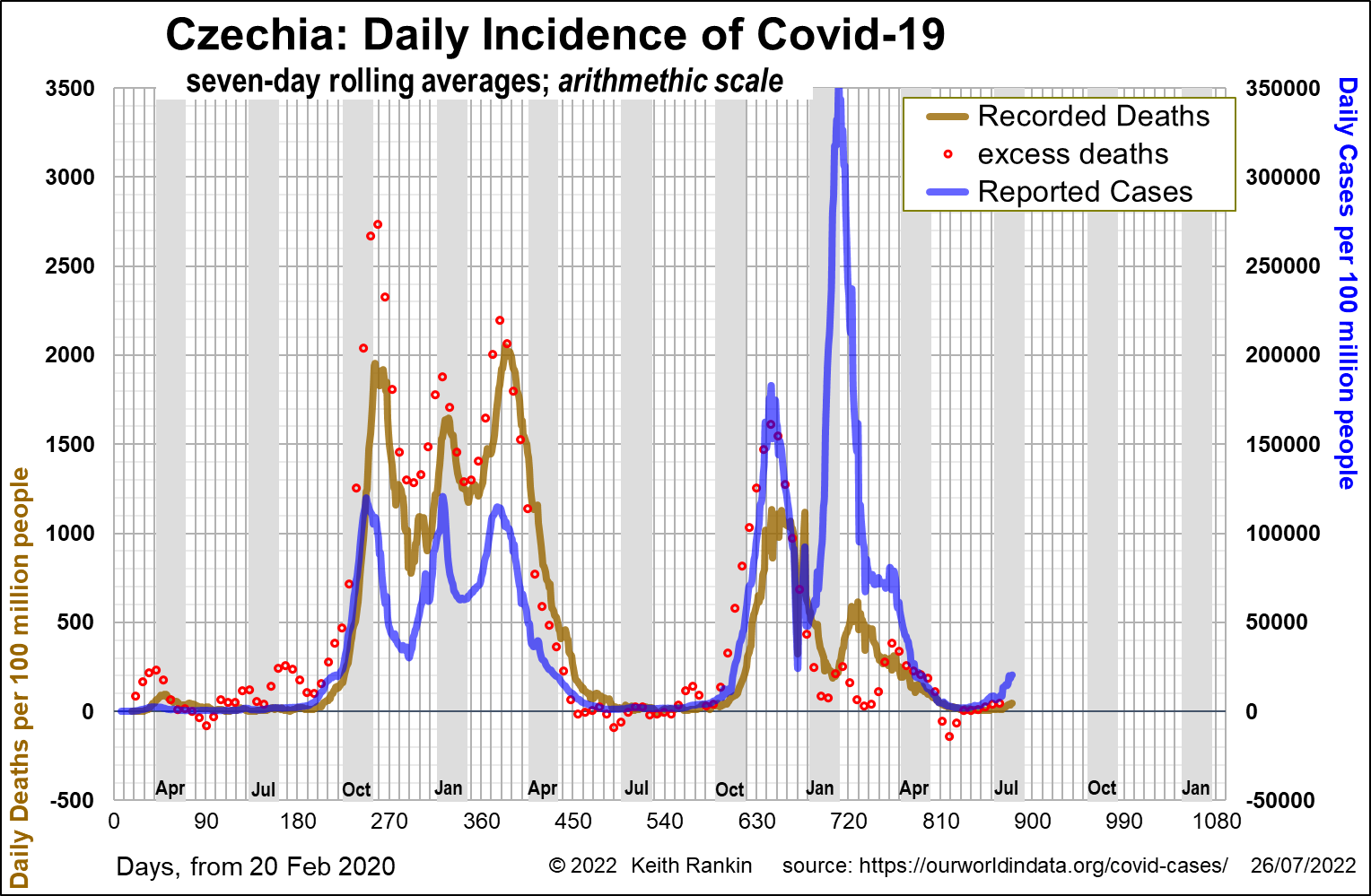
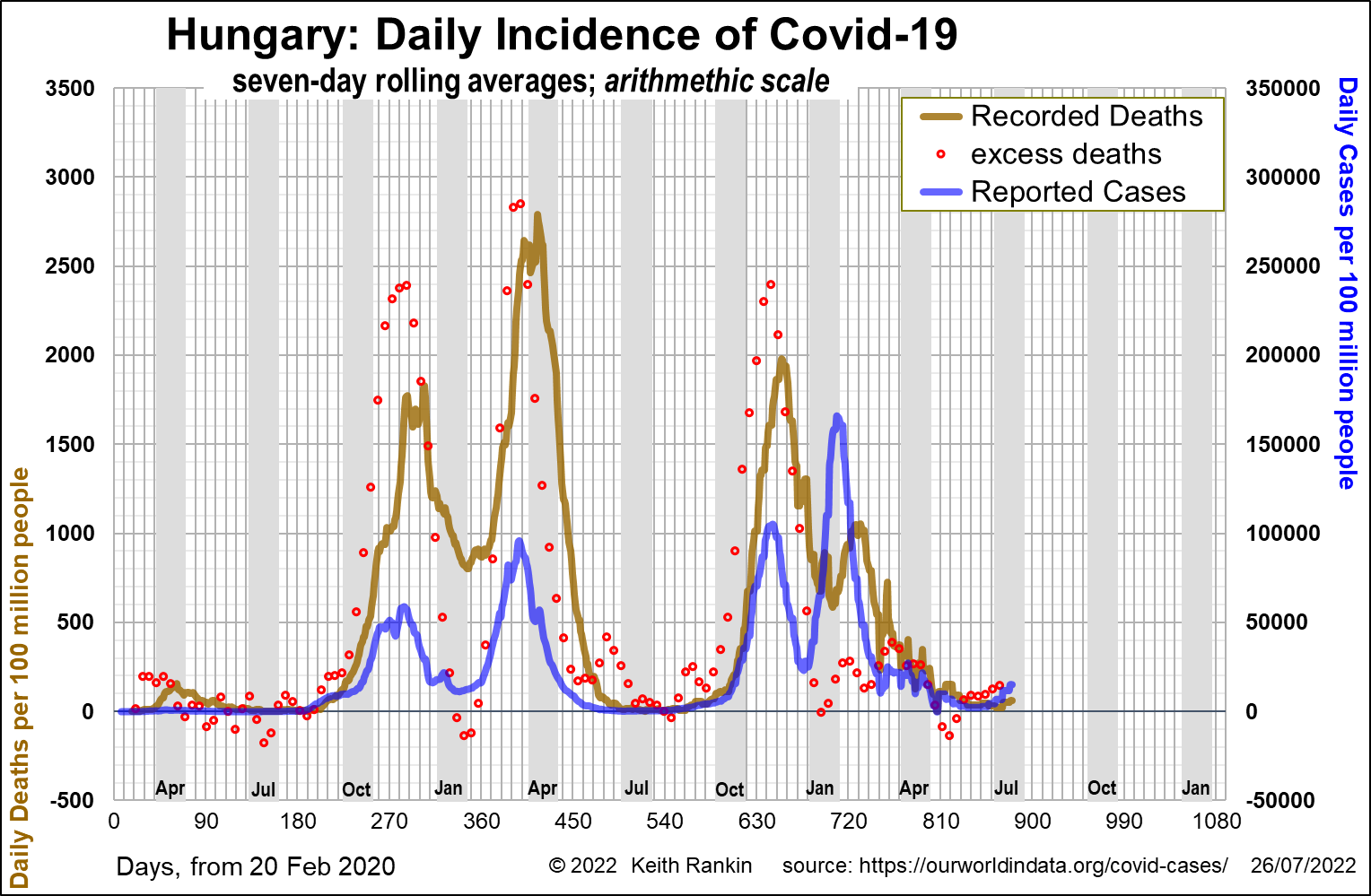
The first and most important things to note are that Czechia and Hungary successfully suppressed Covid19 until September 2020; they were significantly more successful than even Germany, in this respect. The pattern then shows a particularly severe winter of 2020/21; in two or three waves, though the troughs of these waves were probably overstated.
The key issue here is that countries in these temperate latitudes – and North Europe is the best set of test cases – suffer significant winter seasonal epidemics in three or four winters out of five. The timings of these regular epidemics of excess deaths vary; February tends to be worst. This makes it very hard to determine a winter normal for these countries.
In the winters of 2020/21 and 2021/22, covid has to a large extent displaced influenza and other seasonal cullers. Thus, in the peak influenza months, excess deaths from Covid19 may fall. Rather covid has displaced these other illnesses as the principal seasonal culler. That’s why covid deaths are best understood in the context of the fatal illnesses that covid is displacing. (See these charts on Evening Report.)
Czechia ‘lost’ 4480 per million of its population, including 234pm in the first half of this year. Hungary ‘lost’ 4500 per million of its population, including 292pm in the first half of this year. Overall, both countries have lost nearly one in every 200 of their populations, so far. (One in 200 of the world’s population would be 39 million people.)
So far, these Eastern European countries have incurred double the mortality of the major western countries noted here. But they suffered much less in the first six months of the pandemic, and they have seen significantly fewer deaths in the last couple of months. They also suffered surprisingly little in July-September 2021, the Delta wave that was then washing through the whole world.
These countries appear to have suffered a calamitous shift down the immunity gradient during 2020, and then paid the full price. Thus, by mid-2021, they shifted up the immunity gradient; or at least the ‘natural immunity gradient’. With waning vaccination immunity, and lower rates of vaccination, these eastern countries suffered in the late months of 2021 (October and November).
From the abovementioned New York Times article: “Other parts of Europe were even more hands-off [this year]. In the Czech Republic, where there are no restrictions at all, including in hospitals, the virus is running rampant, and officials openly predict an increasing spike in cases.” While Czechia is a place to watch, I suspect that any uptick in covid there will be less than the present covid spike in Germany. Either way, like France and Spain, Czechia and Hungary are presumably dangerous countries for New Zealanders to visit at present.
New Zealand and Sweden
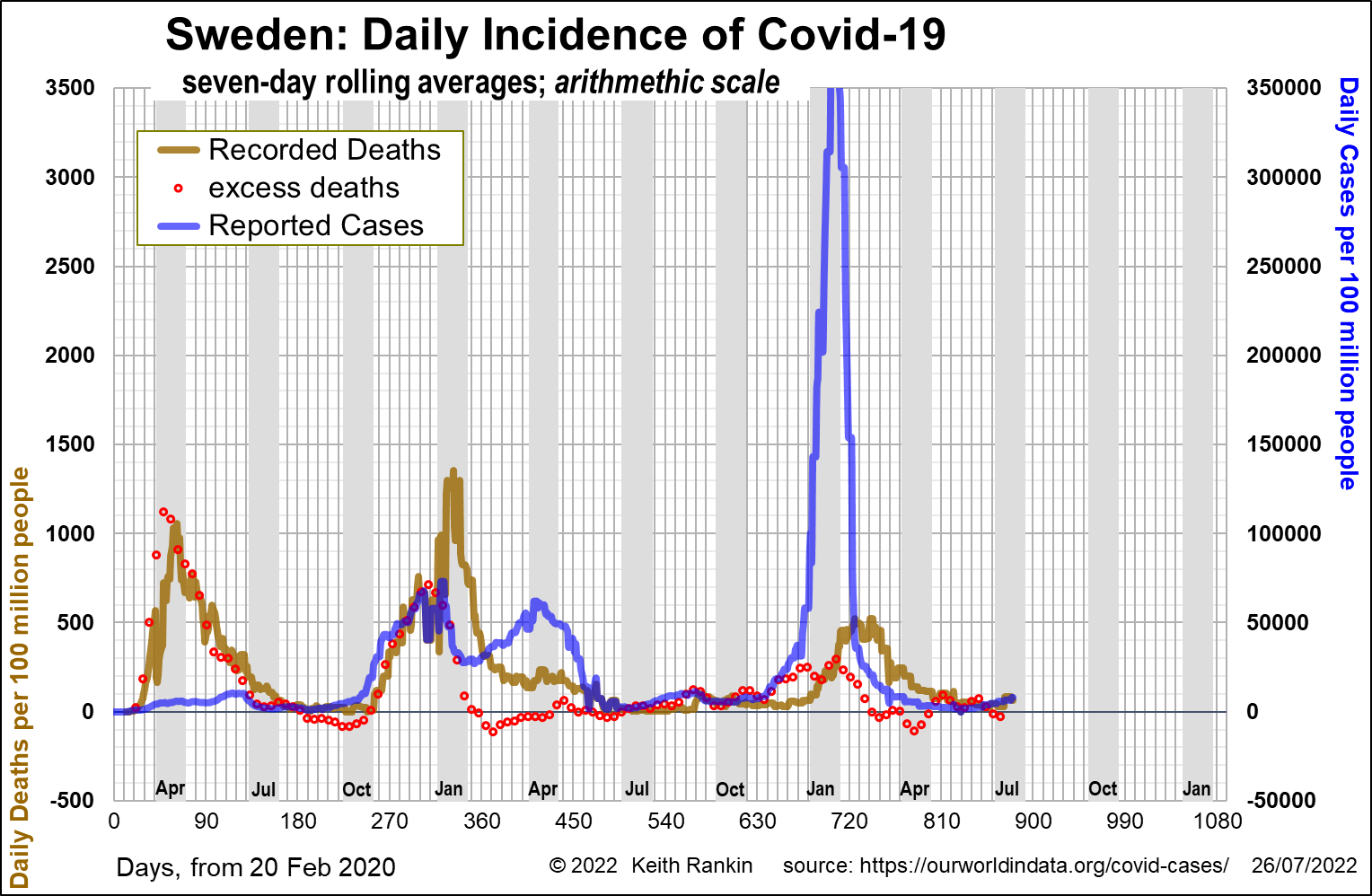
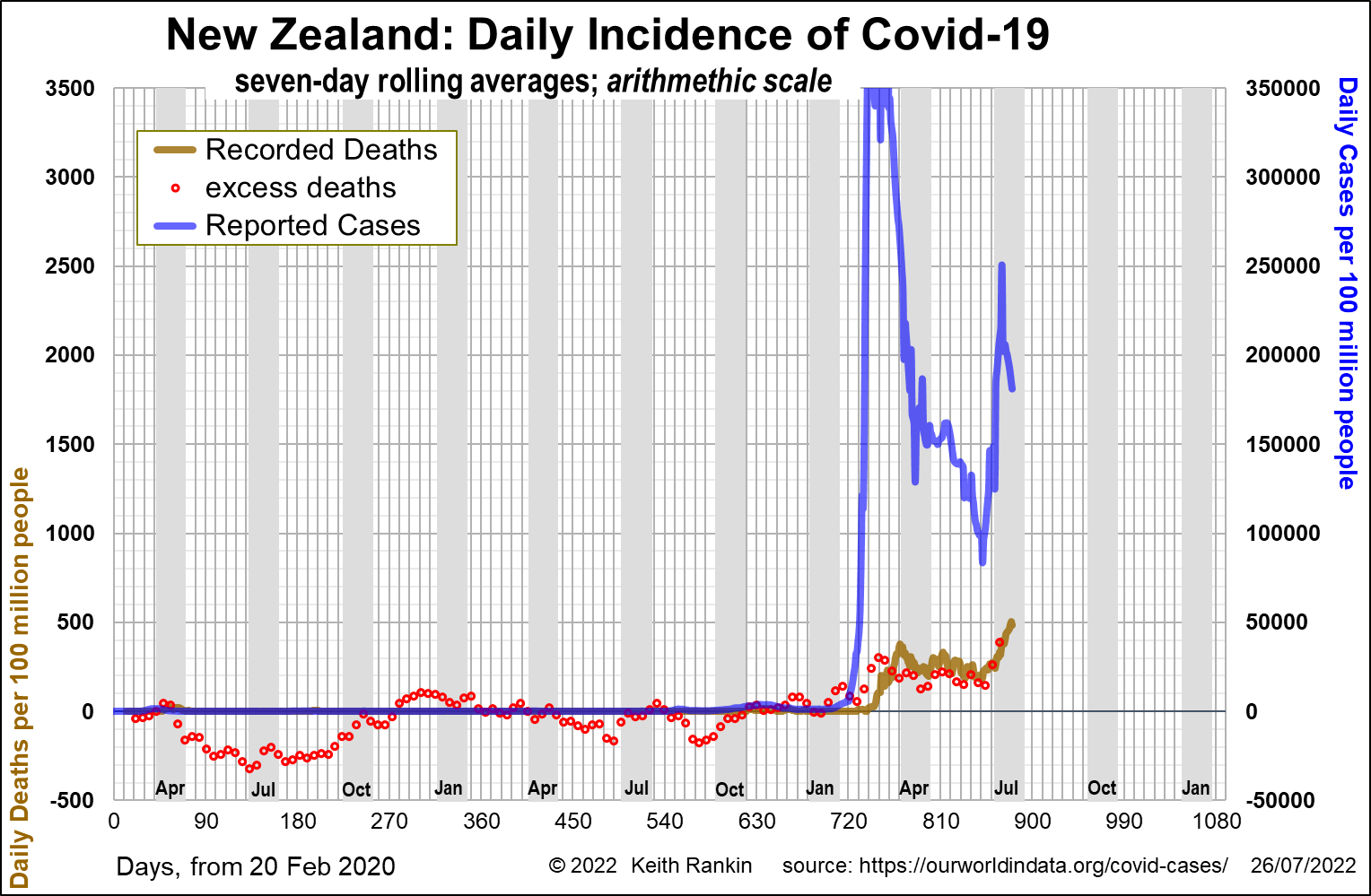
These two countries are widely regarded as the developed capitalist countries which represent the opposite ends of the 2020 ‘stringency spectrum’. Sweden’s public health scientists emphasised the importance of population natural immunity as the key to good public health outcomes. New Zealand was the poster-child for interventionist mandates with the aim of creating maximum distance between the coronavirus and the people. New Zealand and Australia took more cues than Europe from those East Asian countries which were at the frontline of the successful suppression of the more lethal (though less transmissible) SARS1 coronavirus.
Sweden ‘lost’ 1210 per million of its population, including 128pm in the first half of this year. New Zealand ‘lost’ minus 220 per million of its population, though plus 272pm in the first half of this year.
Looking backwards, New Zealand has ‘done best’, though its excess deaths this year are comparable to all the other countries mentioned here (except Sweden which has done the best of the developed capitalist countries this year).
What matters, clearly, is the next phase of the pandemic. New Zealand is clearly, at present, well down the immunity gradient. New Zealand remains very vulnerable to international visitors bringing new strains of respiratory (and maybe some non-respiratory) pathogens.
The charts suggest that Spain, France, Czechia, Hungary and Sweden will have comparatively low excess mortality in the coming year and a half. My sense is that Germany will have higher ongoing mortality rates than these neighbours and near-neighbours.
My concern is for New Zealand, ‘going forward’, and with those other western Pacific countries that have taken bigger covid tolls in 2022 than in the previous two years combined. A particular point to note is that the next wave – the coming summer wave (or late spring) wave – will have a higher excess death toll than the present wave.
We see that, in many countries, Covid19 remains much more than a ‘winter’ illness. New Zealand at present is still seeing (at least in the early winter) rising covid-deaths offset by lower than normal non-covid winter deaths. When New Zealand gets to the late-spring or summer, there will be no such offset. Rather, in November or December, New Zealand could suffer a covid death spike similar to those this year faced by South Korea and Taiwan.
In terms of published data, New Zealand had the most covid deaths in the world last week. For some reason this known fact did not make the headlines. (This week New Zealand has been overtaken by Martinique and Anguilla, pointing to a new Caribbean covid wave. Just now is the peak of European and North American tourism into the Caribbean holiday destinations.) Further, while published cases and deaths have held steady in New Zealand over the last week, hospitalisations are rising again in the most recent data. It is possible that New Zealand will suffer over 800pm excess deaths in the second half of 2022; that’s another 4,000 people.
Below is the screenshot from Worldometer from Friday 22 July, showing New Zealand in its place at the top of the table for reported Covid19 deaths. The table is sorted by deaths per million people in each country’s population.
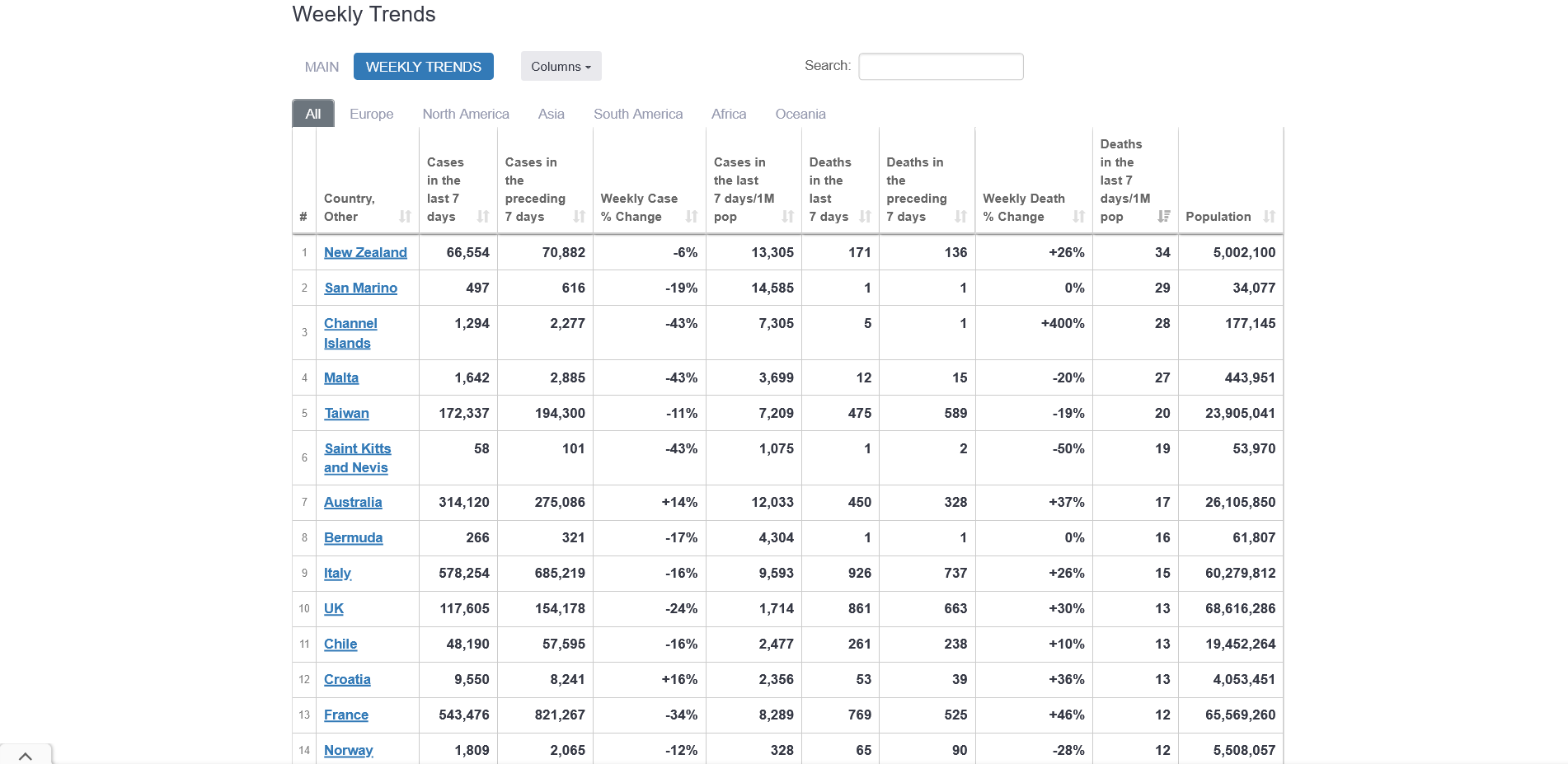
Context of the Immunity Gradient
Johan Anderberg, in The Herd, cites Hungary and Poland – and Spain and France – as being among “countries that had shutdown playgrounds, forced children to wear facemasks, closed schools, fined citizens for hanging out on the beach, and surveilled parks with drones” (p.298). And he includes Germany, Czechia and Hungary “among countries that hadn’t been affected in the spring and thus lacked immunity” as having problematic experiences at the end on 2020 (p.292). Hungary, “where Viktor Orbán had invoked the threat of the virus to strengthen his power”, gets a special mention for the initial strength of its anti-covid response (p.260).
Re the matter of children, on RNZ today I heard a news report about this story: Likely cause of mystery child hepatitis outbreak found. This story provides significant counter-evidence against requiring younger children to isolate and wear facemasks. Presumably, adenoviruses have been in short supply in New Zealand too, especially given the prolonged closures of New Zealand’s international borders.
It’s more important than ever that the blindspots in New Zealand’s official covid narrative are exposed. Many countries desperately need a scientific scrutiny of facts, and not just a lazy presumption that a few overexposed experts are presenting all the known facts to the New Zealand public; all the facts about New Zealanders’ – and other peoples of the Western Pacific – changing vulnerability to Covid19 and other infectious diseases.
Instead, the latest reporting of Covid19 [RNZ] is substantially downplaying deaths, with no daily death total given in the press release, and no further mentions of people dying ‘with covid’. If the reporting had been done the same as last week, there would have been a record high daily death total of 40. Even under the new tighter definition, the latest daily covid death toll is 29, also close to the daily record.
*******
Keith Rankin (keith at rankin dot nz), trained as an economic historian, is a retired lecturer in Economics and Statistics. He lives in Auckland, New Zealand.







